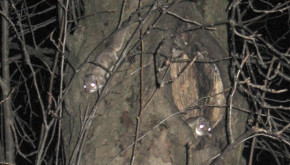
The Southern Flying Squirrel
This creature can proudly claim to be the only of Ohio’s 4 species of tree squirrels that can ‘fly’ from tree to tree! That’s not all it can lay claim to. It is also the only nocturnal tree squirrel, the smallest, the most carnivorous, and in many forests is the most abundant in numbers, at times rivaling the eastern gray squirrel. This latter fact is often hard for people to believe since these small squirrels are never seen as often as the eastern gray squirrel due to their night time hours and covert behaviors.
The grayish-brown furred southern flying squirrel can be found all over the state of Ohio in deciduous forest along with Ohio’s other 3 species of tree squirrels, the eastern gray squirrel, eastern fox squirrel, and the red squirrel. The red squirrel, however, is found more often in coniferous forests due to its preference towards pine cone seeds as food. Speaking of food – the southern flying squirrel will feast on a great variety of things such as nuts, berries, fungi, birds and their nestlings, small mammals, and sometimes even carrion. They also share an appetite for insects like another common night-time creature, the bat.
While they will not pass up a tasty moth or beetle just like a bat won’t, the southern flying squirrel can not truly claim to fly like a bat does. It more accurately glides from tree to tree using a fold of skin between foreleg and hindleg acting as a combination parachute and hang glider. While they do not flap their arms in true flight as bats and birds do, this gliding sometimes 80 meters through the air can definitely get them where they need to go in a hurry!
Interested in seeing these night-time aerialists? This may prove difficult despite their abundance in numbers. After braking to a stop on a tree trunk or branch, they will often scurry quickly around the opposite side to hide from any would-be predators that might have seen their airborne display. They are agile and extremely sure-footed aloft; however, they do leave indications of their presence. During the day, venture through the woods and look for nests in trees made of leaves, twigs and bark that are about 15-20 feet from the ground. They look very similar to the nests built by the larger fox and gray squirrel, but are only 8 inches in diameter. Flying squirrels also like to nest in holes made by woodpeckers, so keep an eye on those potential nest sites as well.
During the night, flying squirrels will communicate using a high pitched chirping that sounds a lot like a bird. If you can pinpoint the tree it is coming from, sometimes you can spot the squirrel with a red spotlight (the red light will not disrupt yours or the squirrel’s night vision). Finally, if you are feeling really ambitious, for about a week or so before you plan a night excursion in search of these critters, bait some trees for them by placing a smear of peanut butter on the trunk as high up as you can reach. After dark, shine a light on these trees to see if you can catch some feeding action, or at the very least, examine the peanut butter for claw or bite marks. Be patient and quiet and you may be awarded with a glimpse of the southern flying squirrel!
Do you have flying squirrel habitat? They are an interior forest species (beech-maple, oak-hickory) with a preference for a mixture of older and younger trees – an uneven-aged forest. Flying squirrels like open canopies that allow them to glide. Near the forest floor they prefer more density that allows them protection from predators. They feed on acorns and other seeds and nuts along with berries, buds and blossoms. Since they are cavity nesters, create snags and maintain 1-2 den trees per acre that are at least 20 inches in diameter or larger. They prefer cavities with 1 ½ - 2” diameter holes – like those left by woodpeckers. Want to try nest boxes? They should be placed at least 60 feet in from the forest edge and approximately 10-20 feet up on a tree. Plans are available at http://www.flyingsquirrels.com/boxplans.html .
Marne Titchenell, Wildlife Specialist, OSU Extension, School of Environment & Natural Resources
Kathy Smith, Forestry Program Director, OSU Extension, School of Environment & Natural Resources

